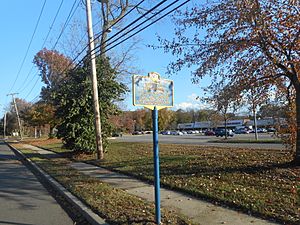Battle of Fort Slongo facts for kids
Quick facts for kids Battle of Fort Slongo |
|||||||
|---|---|---|---|---|---|---|---|
| Part of the American Revolutionary War | |||||||
 Historic marker for the Battle of Fort Slongo, along eastbound New York State Route 25A on Smithtown's side of Fort Salonga, New York |
|||||||
|
|||||||
| Belligerents | |||||||
| Commanders and leaders | |||||||
| Benjamin Tallmadge Lemuel Trescott |
|||||||
| Strength | |||||||
| 100 infantry | 80–140 infantry | ||||||
| Casualties and losses | |||||||
| 1 wounded | 4 killed 2 wounded 21 captured |
||||||
The Battle of Fort Slongo (also called Salonga) was a small but important fight during the American Revolutionary War. It happened on October 3, 1781. American soldiers from the Continental Army attacked a British fort. The fort was located near what is now Fort Salonga, New York. American leaders in this battle were Benjamin Tallmadge and Lemuel Trescott. The Americans won this battle.
Contents
Why Fort Slongo Was Built
The British army built Fort Slongo around 1778 or 1779. This was when they were building many forts on Long Island. Fort Slongo was smaller than Fort Franklin, another British fort nearby. A man named George Slongo helped build it, and the fort was named after him. The British built this fort because it was in a good spot. It overlooked Long Island Sound, which was important for controlling the area.
Planning the Attack
On October 1, American soldiers started planning their attack. Sergeant Elijah Churchill led a small group to scout the fort. They landed their boats at Crab Meadow, west of the fort. Then, they went to a nearby farm owned by Nathaniel Skidmore. Nathaniel helped them look at the fort to plan their surprise attack. Many British officers were at a party the night before the battle. The main British commander, Major Valanstine, was not at the fort. He was in New York City for military duties.
The Battle Begins
On the night of October 2, 100 American soldiers left Norwalk, Connecticut. They were led by Benjamin Tallmadge and Major Lemuel Trescott. They crossed the Long Island Sound in small boats called whaleboats. Trescott's group had 50 men from Captain Richard's Company and 50 men from Captain Edgar's Dragoons.
Surprise Attack on the Fort
The Americans landed early in the morning on October 3. Captain Edgar's dragoons were told to attack the fort by surprise. Captain Richard's infantry surrounded the fort. This was to stop any British soldiers from running away.
At 3:00 AM, Lieutenant Rogers started the attack. He was from the 2nd Continental Light Dragoons. Major Trescott and Captain Edgar's soldiers followed him. A British guard saw them and fired his gun to warn the fort. He ran inside but forgot to close the gate. Colonel Tallmadge wrote in his journal that the British fought back for a short time. The Americans killed 4 British soldiers and wounded 2 more.
After the Battle
After the Americans took control, they burned the fort's buildings. They also destroyed all the supplies stored there. This made the fort useless for the rest of the war. They destroyed two large cannons. The Americans also captured two British captains, one lieutenant, and 18 regular soldiers. They took two small cannons and one brass cannon.
Only one American soldier was hurt in the battle: Sergeant Elijah Churchill. He was later given a special award by George Washington. This award was called the Badge of Military Merit. Sergeant Churchill was the first person ever to receive this award, which is now known as the Purple Heart. Today, you can still find parts of the old fort in a neighborhood in Fort Salonga.

